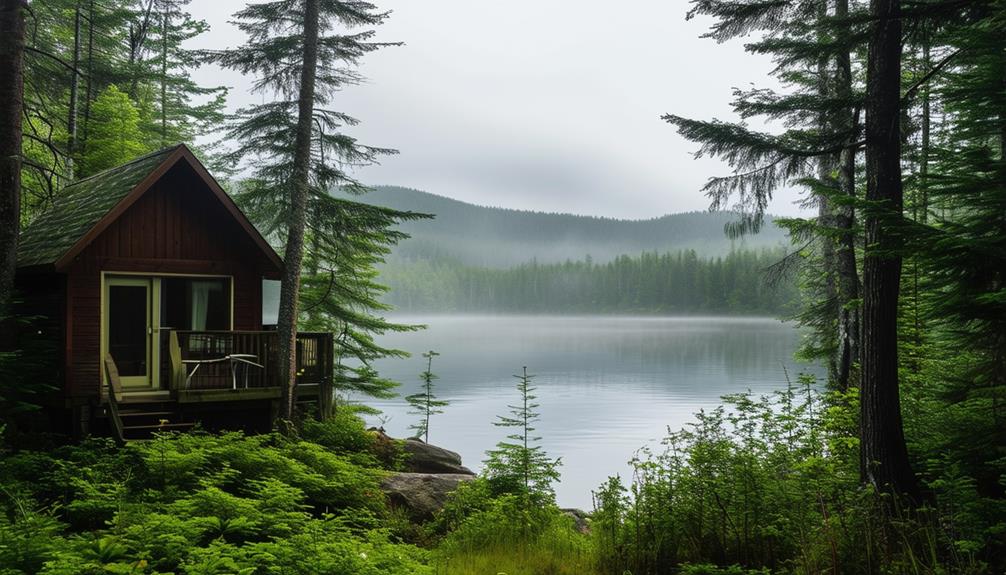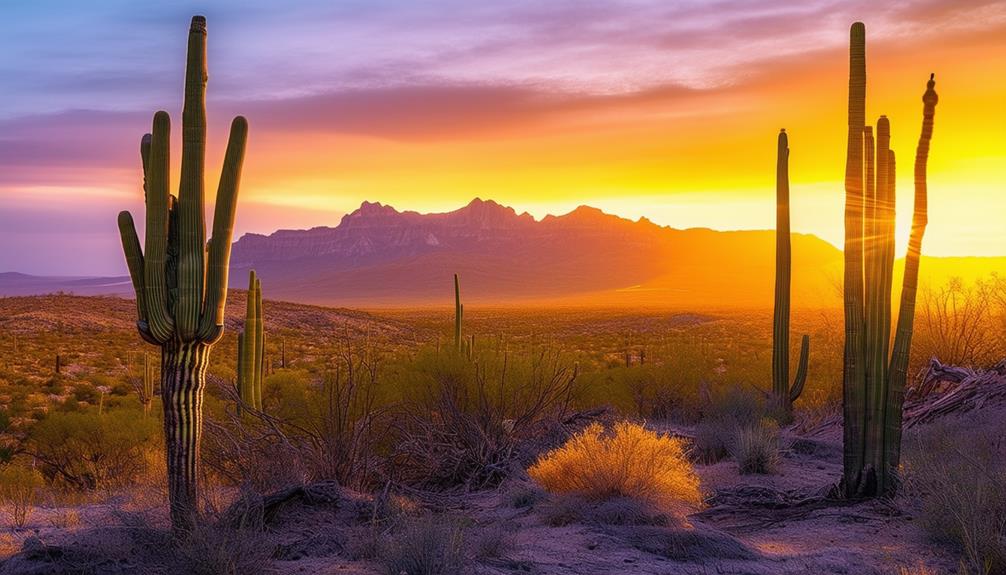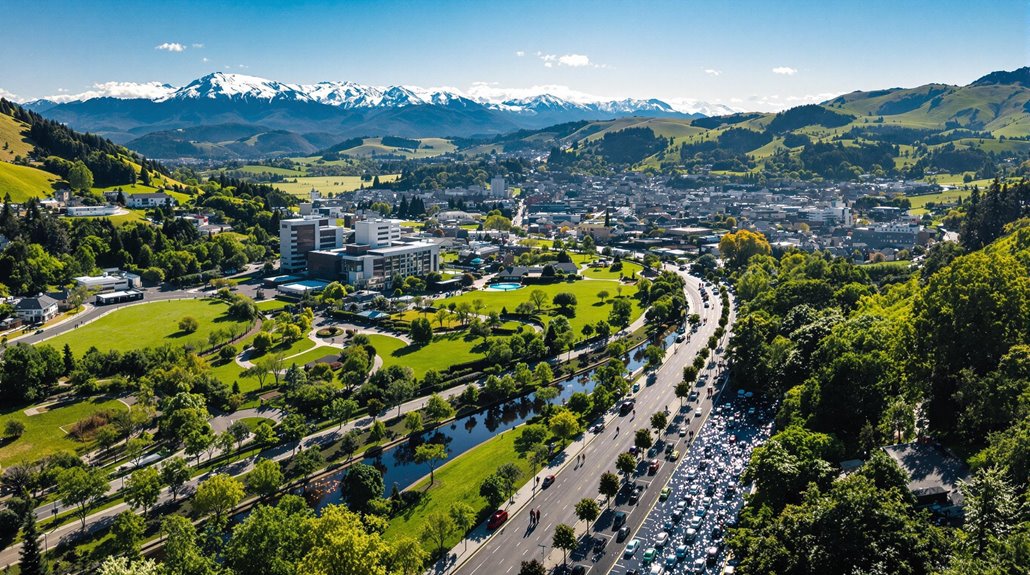Top 10 Best Bug Out Locations in the United States

When considering the top bug-out locations in the United States, each region offers unique benefits for those seeking safety and self-sufficiency. Imagine the isolation and abundant resources of the Rocky Mountains or the fertile lands of the Pacific Northwest.
The seclusion provided by Idaho's wilderness or the prepper-friendly culture in Northern Maine also makes them appealing options. Exploring these areas reveals why they are ideal for off-grid living and emergency preparedness, making them some of the best places to secure your future.
Rocky Mountains

When considering a bug-out location, the Rocky Mountains offer unparalleled rugged terrain ideal for isolation and security. The vast expanse of the Rockies provides a formidable natural barrier, making it difficult for anyone to stumble upon your hideaway. This rugged terrain is crucial for maintaining privacy and safety.
In terms of natural resources, the Rocky Mountains are abundant. You'll find pristine freshwater sources from mountain streams and alpine lakes. The wildlife offers numerous hunting opportunities, while the vast forests supply ample timber for building and fuel.
Choosing the Rockies as your bug-out location also presents numerous opportunities to hone your survival skills. From mastering challenging trails to excelling in fishing and foraging, this environment will keep you sharp and self-reliant. The isolation allows you to focus on self-sufficiency, such as growing your own food and living off the land.
Moreover, the remote locations and natural beauty of the Rockies provide a serene, undisturbed setting for those looking to escape urban chaos. Your bug-out lifestyle will be supported by numerous hiking trails, fishing spots, and camping areas, making the Rocky Mountains an ideal choice for sustainable, long-term survival.
Appalachian Mountains
The Appalachian Mountains serve as an ideal bug-out location due to their abundant natural resources and strategic defense advantages. The region's rugged terrain and secluded areas provide both security and shelter opportunities. Additionally, the local communities are known for their self-sufficiency and survival skills, offering valuable support systems.
Natural Resources Abundance
Exploring the Appalachian Mountains reveals an abundance of natural resources essential for sustainable living. The region boasts numerous freshwater sources, vital for drinking and other daily needs. Edible plants are plentiful, enabling foraging for food without solely relying on stored supplies. The area's rich biodiversity offers ample hunting and fishing opportunities, ensuring a reliable source of protein from game and fish.
The dense forests provide ample wood for constructing shelters and tools, while natural shelters like caves and rock formations offer immediate protection from the elements. The fertile soil in the Appalachian region is ideal for growing crops, allowing for long-term food cultivation.
The varied terrain supports a diverse ecosystem, making the Appalachian Mountains an ideal location for self-sufficient living. Whether foraging, hunting, fishing, or building, the natural resources in this area provide everything needed to thrive. This resource abundance makes the Appalachian Mountains an excellent choice for a bug-out location, ensuring all necessary elements for a sustainable and resilient lifestyle are met.
Strategic Defense Advantages
Located within the Appalachian Mountains, you'll find significant natural defense benefits that make this region an ideal choice for a bug-out location. The rugged terrain and dense forests provide numerous strategic advantages, ensuring both safety and privacy.
First and foremost, the mountainous terrain offers excellent vantage points, allowing for effective monitoring of the surroundings. This makes it easier to detect potential threats from a distance. Furthermore, the dense forests serve as natural camouflage, concealing bug-out shelters and making them difficult for outsiders to locate.
Key benefits include:
- Surveillance and Protection: Elevated positions provide superior vantage points for monitoring and defense.
- Natural Barriers: The rugged terrain creates obstacles that are challenging for intruders to navigate.
- Camouflage: Dense forests offer natural concealment for shelters and activities.
- Isolation: Remote locations limit access, reducing the risk of unwanted encounters.
The isolation of the Appalachian Mountains enhances security by minimizing the likelihood of encounters with others during emergencies. This area offers ample opportunities to establish well-hidden shelters, utilizing the natural landscape to your advantage. The combination of strategic positioning and natural concealment makes the Appalachian Mountains a top-tier choice for serious bug-out planning.
Community Support Systems
Beyond their strategic defense advantages, the Appalachian Mountains are renowned for their robust community support systems, which are invaluable for preppers. This region boasts a population that shares a self-reliant and preparedness mindset, making it one of the best bug-out locations in the United States. The strong community bonds here mean you'll have neighbors ready to assist in times of need, which is crucial for any survival scenario.
Local communities in the Appalachians are well-known for their willingness to help each other during emergencies. This collaborative spirit enhances survival strategies by facilitating the exchange of information and resources among community members. Joining local prepper groups and networks can provide valuable insights and skills, ensuring you are well-prepared for any situation.
The mountainous terrain not only offers natural defense but also fosters a sense of isolation that can be advantageous for long-term survival. The community support systems in the Appalachian Mountains significantly contribute to making it an ideal bug-out location.
Here's a snapshot of what you'll experience:
| Advantage | Description | Benefit |
|---|---|---|
| Strong Community | Self-reliant, preparedness mindset | Improved support during crises |
| Local Prepper Groups | Information and resource sharing | Enhanced survival strategies |
| Mountainous Terrain | Natural defense and isolation | Long-term survivability |
These factors combined make the Appalachian Mountains a prime destination for any dedicated prepper.
Pacific Northwest

When considering the Pacific Northwest for your bug-out location, you'll find abundant natural resources like water, forests, and wildlife, making sustainable living feasible. The region's low population density means less competition for these resources and a higher level of safety. Moreover, the temperate climate and fertile land are ideal for farming, ensuring a reliable food supply.
Abundant Natural Resources
Harnessing the abundant natural resources in the Pacific Northwest can significantly enhance your chances of sustainable living in a bug-out scenario. The region is a treasure trove for those looking to live off the land, offering rich biodiversity that supports hunting, fishing, and foraging.
Imagine catching fresh fish from the Columbia River or Puget Sound, which also serve as vital clean water sources for your survival. The temperate climate in this area allows for year-round agriculture, making it feasible to grow your food regardless of the season. The vast forests and varied terrain, including mountains and valleys, provide both shelter and resources.
To optimize your survival capabilities, consider these key benefits:
- Hunting: The diverse wildlife in the forests provides a steady supply of meat.
- Fishing: Rivers and lakes are teeming with fish, offering a reliable protein source.
- Foraging: Abundant plant life makes it easy to gather edible berries, nuts, and mushrooms.
- Clean Water Sources: Access to rivers and lakes ensures a continuous supply of fresh water.
Low Population Density
The Pacific Northwest's sparse population density offers preppers an ideal environment for isolation and security. States like Idaho, Montana, and Wyoming feature vast, thinly populated areas that are perfect for establishing a bug-out location. These remote regions minimize the risk of conflicts over resources, making it easier to maintain a sustainable, off-grid lifestyle.
The low population density in this area means fewer people around, reducing the likelihood of encountering threats during a crisis. For example, Idaho's expansive spaces and rugged terrain provide the seclusion needed to stay under the radar.
Similarly, Montana's extensive wilderness areas offer plenty of room to set up a secure base without the worry of being discovered. Wyoming also has large, uninhabited regions that ensure ample privacy and security.
Favorable Climate Conditions
The Pacific Northwest's mild temperatures and abundant rainfall make it an ideal region for year-round off-grid living. The favorable climate supports sustainable agriculture, enabling the cultivation of various crops and maintaining a thriving garden without the concern of extreme weather. Additionally, coastal areas provide ample seafood and freshwater resources, enhancing self-sufficiency.
Here are four key reasons why the Pacific Northwest is favorable for bug-out locations:
- Moderate Temperatures: The region's temperate climate avoids the extremes of heat and cold, making long-term survival more manageable.
- Ample Rainfall: Consistent rainfall ensures abundant water resources, essential for drinking, irrigation, and hygiene.
- Sustainable Agriculture: Fertile land supports diverse farming and gardening efforts, providing a reliable food source.
- Coastal Resources: Proximity to the coast offers access to seafood and freshwater sources, enhancing the ability to live off the land.
Furthermore, the Pacific Northwest's low population density reduces competition for resources, increasing the likelihood of finding a secure and secluded bug-out location.
Gulf Coast
Situated along the southern edge of the United States, the Gulf Coast offers a unique blend of resources and resilience, making it an ideal bug-out location. Rich in aquatic and terrestrial food resources, this region provides ample opportunities for survival. The Gulf Coast's abundant seafood—fish, shrimp, and crabs—ensures a consistent supply of protein.
In addition to fishing, the subtropical climate allows for year-round cultivation of various crops, facilitating a sustainable food supply. The proximity to waterways enhances not only food sourcing but also navigation and transportation, offering logistical flexibility.
A notable feature of the Gulf Coast is its robust hurricane preparedness and recovery infrastructure. Coastal communities are skilled in handling storms, and the infrastructure is designed to withstand such events. This means you'll find a community equipped with the knowledge and resources to survive and rebuild. If you seek a bug-out location that combines natural resources with a resilient community, the Gulf Coast is a strong candidate.
Texas Hill Country

Texas Hill Country, with its rolling terrains and abundant resources, offers an ideal setting for a sustainable bug-out location. If you're crafting a bug-out plan, this region is a top contender for several compelling reasons.
Firstly, the sparse population density means you'll encounter less competition for resources, enhancing your chances for long-term survival. The area is rich in natural resources like water, wildlife, and fertile land, which are essential for sustaining yourself and your family over extended periods.
Another significant advantage of Texas Hill Country is its proximity to major cities such as San Antonio and Austin. This accessibility offers opportunities for supply runs and acquiring necessary resources without compromising your remote location.
Furthermore, the community support in this region shouldn't be underestimated. The people here often share a prepper-friendly culture, which can be invaluable in challenging times.
Here are four key reasons to consider Texas Hill Country for your bug-out plan:
- Sparse population density: Less competition for resources.
- Abundant natural resources: Water, wildlife, and fertile land.
- Proximity to major cities: Easy access for supply runs.
- Community support: Strong, supportive, prepper-friendly culture.
Ozark Mountains
The Ozark Mountains offer rugged terrain, dense forests, and abundant natural resources, making them an excellent choice for survival scenarios. This region combines natural beauty with practical assets, ideal for a bug-out location. With a low population density, the risk of encountering others is minimized, allowing for a high degree of privacy and security.
The Ozarks are rich in wildlife, providing ample opportunities for hunting and foraging. The dense forests are home to deer, wild turkey, and small game, ensuring a reliable food supply. Additionally, the region boasts diverse water sources, including rivers and streams, crucial for drinking and fishing, enhancing self-sufficiency.
The rugged terrain and dense forests also serve as natural barriers, offering added protection and concealment. In the Ozark Mountains, you'll find the essential elements needed to thrive in a bug-out scenario, making it one of the top choices for a dependable survival location.
Northern Maine

Northern Maine offers a secure and peaceful bug-out location with its low population density and abundant natural resources. The area's plentiful water, rock, and timber make it ideal for those seeking a self-sufficient, off-the-grid lifestyle.
To thrive in Northern Maine, consider the following:
- Low Population Density: A sparsely populated area reduces the risk of encountering threats, enhancing security.
- Abundant Natural Resources: Leverage the available water, rock, and timber to build and sustain your bug-out haven.
- Off-the-Grid Living: The low cost of living in remote areas facilitates investment in sustainable practices and energy sources.
- Sustainable Food Sources: The short growing season necessitates indoor growing methods like greenhouses and hydroponics to maintain a steady food supply.
Northern Maine's tranquil rural lifestyle, combined with its practical resources, makes it a premier choice for those seeking secure and independent living.
Great Smoky Mountains
The Great Smoky Mountains offer an exceptional bug-out location, characterized by diverse wildlife, abundant freshwater sources, and plentiful natural shelter options. You'll find yourself in a remote and secluded area, ideal for staying off the grid. The wildlife, including black bears, deer, and wild turkeys, provides ample hunting and foraging opportunities, ensuring you can sustain yourself in the wild.
Freshwater is abundant, with rivers, streams, and waterfalls offering reliable hydration sources. The dense forests and rugged terrain provide natural shelter and concealment, making it easier to find or create a safe haven. Whether you build a temporary shelter or establish a more permanent camp, the Smokies offer the necessary resources.
The region's mild climate features four distinct seasons, promoting year-round survival and outdoor activities. Summers are warm but not extreme, and winters are mild compared to other mountainous areas, facilitating adaptation and thriving in any season.
Arizona Desert

Located in the southwestern United States, the Arizona Desert offers a unique and viable bug-out location due to its arid climate and plentiful sunshine. The dry conditions reduce weather-related challenges, making day-to-day survival more manageable. Additionally, the abundant sunlight allows for harnessing solar energy, providing a reliable power source for an off-grid lifestyle.
The desert's seclusion adds an extra layer of security. With fewer people around, the risk of conflicts over supplies is significantly reduced. The rough terrain and vast open spaces further enhance opportunities for privacy and safety.
For sustainable living, the Arizona Desert is surprisingly supportive. Diverse cacti species and wildlife can serve as food sources, while underground water sources can be tapped for hydration needs.
Here are four reasons why the Arizona Desert stands out:
- Arid Climate: Ideal for year-round survival with minimal weather disruptions.
- Plentiful Sunshine: Perfect for generating solar energy.
- Secluded Areas: Lower risk of supply conflicts and enhanced security.
- Natural Resources: Cacti, wildlife, and underground water support sustainable living.
Montana Wilderness
When considering the Montana wilderness as a bug-out location, you'll find abundant natural resources that support long-term survival. Its remote and secure areas offer the seclusion necessary to escape urban chaos.
With access to wildlife, clean water, and edible plants, you'll have the essentials to thrive off the grid.
Abundant Natural Resources
Montana's wilderness offers a wealth of natural resources essential for survival, making it an ideal haven for preppers seeking self-sufficiency. The region provides:
- Clean Water Sources: Numerous rivers, lakes, and streams ensure a reliable supply of fresh, clean water, crucial for any long-term survival plan.
- Abundant Game: The area is rich with elk, deer, and smaller game, providing a steady food source for those proficient in hunting and trapping.
- Edible Plants: The wilderness is teeming with edible plants and berries, adding vital nutrients to your diet.
- Pristine Environment: Montana's unspoiled environment means fewer pollutants, simplifying safe foraging and promoting good health.
Remote and Secure
Montana's vast wilderness offers abundant natural resources and provides remote, secure locations ideal for those seeking isolation and safety during emergencies. The untouched nature of Montana is perfect for survival, with minimal human presence and abundant wildlife. Clean water sources are plentiful, making hydration easier, while the diverse fauna offers ample hunting opportunities for food.
Living off-grid in Montana's wilderness can enhance your sense of security during uncertain times. The remote locations act as a natural barrier against intruders, providing peace of mind. Additionally, there's plenty of wood for building shelters, ensuring a safe and sturdy place to stay.
Self-sufficiency is crucial in the Montana wilderness. The region allows you to develop essential survival skills, from foraging to hunting, helping you thrive even when cut off from modern conveniences. Whether you're a seasoned prepper or just starting, Montana's wilderness offers an excellent backdrop for a secure, off-grid lifestyle.
The remoteness of this area ensures that you'll have the isolation needed to endure emergencies safely and comfortably.
Conclusion
The United States offers a variety of excellent bug-out locations. Whether you prefer the rugged terrain of the Rocky Mountains, the historic Appalachian Mountains, or the fertile lands of the Pacific Northwest and Gulf Coast, there's a suitable spot for you.
Idaho, Montana, and Wyoming provide seclusion, while Texas Hill Country and the Ozark Mountains are known for their prepper-friendly communities. The Great Smoky Mountains and the Arizona Desert also stand out for their diverse wildlife.
Choose wisely and stay prepared!




